Mockingbirds & Thrashers
Songbirds truly worthy of the name are the members of the family Mimidae: the mockingbirds, catbirds, and thrashers. Some of them, especially the mockingbirds, borrow phrases from other birds—or from other sounds in their surroundings—but they work them into improvisations that are rich and musical, or at least interesting.
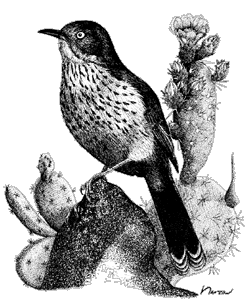 |
Although a couple of species are common in eastern gardens, and various types of mockingbirds occur throughout the Americas, the family reaches its greatest development in the arid American Southwest. There are some places where the Mockingbird and up to four species of thrashers may be found nesting in the same patch of desert. Differences in the shapes of their bills reflect differences in their feeding behavior, and probably explain how all these related birds can coexist. For example, the Crissal Thrasher, thrashing the soil with its big sickle-shaped bill, can probably root out insects that are unavailable for the short-billed Bendire’s Thrasher. There are also slight differences in habitat choice; Le Conte’s Thrashers, for example, are found side by side with other thrashers in some places, but their range also extends out onto barren saltbush flats where there are few other birds.
Some thrashers are secretive birds, difficult to observe, but not the Curve-billed Thrasher. Bold and inquisitive, it runs in the open and calls “whit-wheet!” from prominent perches. In parts of the Southwest it has adapted to advancing civilization almost as well as the mockingbird. Curve-billed Thrashers may even thrive in the middle of cities, as long as they can find a few cholla cacti in which to place their nests.
—Kenn KaufmanMockingbirds & Thrashers
Representative Sonoran Desert species:
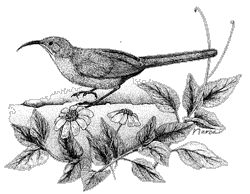 |
Northern Mockingbird (Mimus polyglottos)
Le Conte’s Thrasher (Toxostoma lecontei)
Bendire’s Thrasher (Toxostoma bendirei)
Curve-billed Thrasher (Toxostoma curvirostre)
Crissal Thrasher (Toxostoma crissale)
Gray Thrasher (Toxostoma cinereum)
Order: Passeriformes
Family: Mimidae (Mockingbirds and Thrashers)
Spanish names: cenzontle norteño, cenzontle, chonte (Mockingbird); cuitlacoche,
güitacochi (Curve-billed Thrasher)
Distinguishing Features
Northern Mockingbird: Grayish-white plumage; flashes of white in the wings and tail that show in flight. This bird is a remarkable mimic of other birds in its area, a characteristic which gives it its genus and species name; often heard singing on moonlit nights.
Le Conte’s Thrasher: Pale gray-brown upperparts with lighter underparts; the tail is dark duskybrown; slender, downcurved bill is black; brown eyes; the palest thrasher.
Bendire’s Thrasher: Short, slightly curved bill; light grayish-brown plumage with faint streaking on breast; yellow eyes; voice is a clear, melodious warble with some repetition and continuing at length.
Curve-billed Thrasher: Well-curved bill; indistinct spots on breast; gray-brown plumage; pale orange eyes; call is a sharp “whit-wheat”; song is a musical series of notes and phrases with little repetition.
Crissal Thrasher: Deeply curved bill, unspotted breast and underparts, dark line below the bill, gray eyes, olive-brown upperparts and lighter gray-brown underparts, reddish undertail.
Gray Thrasher: Slender, gray-brown upperparts; underparts are whitish with triangular or tear-shaped dark spots; outer tail feathers tipped with white; yellow eyes.
Habitat
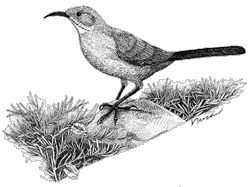 |
The Northern Mockingbird frequents urban areas, ranches, densely wooded washes, and shrub grasslands from the edge of the desert into the lower elevations of mountains. Le Conte’s Thrasher prefers low, hot desert plains with scant vegetation (such as creosote bush or saltbush flats). Bendire’s Thrasher prefers the desert scrub of the Southwest. Curve-billed Thrasher prefers the desert, arid brush, and shrubby woods; also found in southwestern cities as long as cholla are available to provide nesting sites. Crissal Thrasher frequents dense mesquite thickets along streams in the Sonoran Desert; found in dense chaparral in southwestern mountains up to about 6000 feet. Gray Thrasher inhabits desert scrub and mesquite; found in Baja California only.
Feeding
• Diet: Northern Mockingbird: Insects and berries. Le Conte’s Thrasher: Spiders, centipedes, small lizards, berries, and seeds compliment its insect diet. Bendire’s Thrasher: Its predominantly insect diet is complemented with spiders, berries, cactus fruit, and seeds. Curve-billed Thrasher: Insects, fruit, berries, and seeds. Crissal Thrasher: Spiders, small lizards, berries, and small fruits complement its mainly insect diet. Gray Thrasher: Mainly insects.
• Behavior: The Northern Mockingbird forages by walking or running on the ground or flying down to the ground from a perch; often opens and closes wings, a behavior which causes insects to take flight. Perches to eat berries.
Le Conte’s Thrasher foraging takes place on the ground where it uses its bill to dig in the soil for food; feeding usually takes place early morning or at dusk when insects are most active.
Bendire’s Thrasher forages mainly on the ground.
Curve-billed Thrasher forages almost entirely on the ground where it uses its large bill to flick aside debris and dig in the soil in search of food; berries are eaten while perched.
The Crissal Thrasher is seldom seen flying in the open, preferring to keep within thick streamside vegetation; forages on the ground, usually under thick brush; much of its food is found by digging in the soil or hacking the ground with its heavy bill.
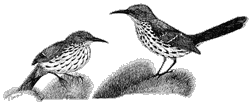 |
The Gray Thrasher is often seen moving on the ground among the scrubby vegetation in search of insects or perched atop a cactus or shrub.
Life History
The Northern Mockingbird builds a small stick nest lined with a few plant fibers in large shrubs or small trees. Here it lays 3 to 4 bluish eggs blotched with brown. These are incubated about 12 days by the female. The young, which are fed by both parents, remain in the nest for 12 to 14 days. Mockingbirds can be quite aggressive towards dogs, cats, other birds, and even humans who come within the vicinity of their nest.
Le Conte’s Thrasher mating pairs, which may mate for life, remain together year-round. Cholla is a preferred nest site, although other low shrubs may be used. The bulky twig nest, which is built by both sexes, is lined with leaves, plant fibers, rootlets and sometimes with softer materials. Pale blue-green eggs (2 to 4) are incubated by both parents and hatch in about 15 days. The young leave the nest about 13 to 17 days after hatching.
The Bendire’s Thrasher nest, which is similar but smaller than other thrasher nests, is built in cholla, yucca and various desert trees and shrubs. The female lays 3 to 5 pale green eggs spotted with brown.The young, which are fed by both parents, leave the nest about 2 weeks after hatching.
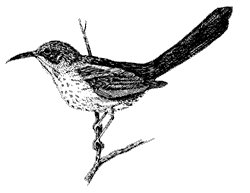 |
Curve-billed Thrasher nesting begins in mid-March to early April. The nest, a loose cup of thorny twigs, is built 3 to 5 feet above the ground in cholla, yucca, or mesquite. It lays 2 to 4 turquoise-colored eggs that are incubated for 12 to 15 days. The altricial young leave the nest at 14 to 18 days. Curve-billed Thrashers may tear apart Cactus Wren nests when good nesting sites are at a premium.
Crissal Thrasher pairs may remain together year-round. The nest, which is a bulky open cup constructed of twigs and lined with softer material, is typically well concealed in mesquites, willows and other dense desert vegetation. Should cowbirds lay eggs in the nest, the adults usually quickly remove them. Pale blue-green eggs (2 to 4) are incubated by both parents. They hatch in about 14 days. The young, which are fed by both parents, leave the nest 11 to 13 days after hatching.










